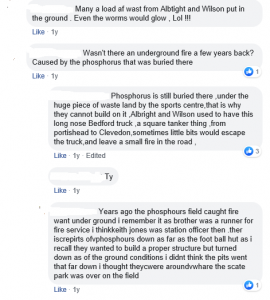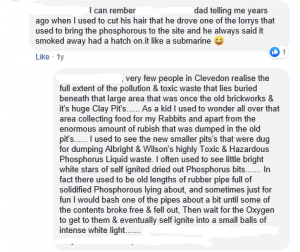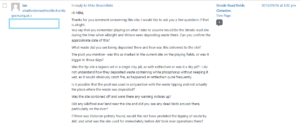LOCATION
This site located in Clevedon, North Somerset is surrounded by Strode Road and Southern Road on two sides, and The River Yeo also adjacent. The Strode sports centre is built on the fields, and an industrial estate also borders the local amenity.
The location of the site can be seen on the map HERE.
CLAIMED HISTORY
There is a familiar limited and selective history of the site officially available, mirroring our experiences with rattlechain, which not surprisingly suits those who do not want to disturb the buried past that the esoteric at the time wanted to conceal. Anecdotal accounts via social media recall familiar scenes that occurred at Rattlechain- fires as a result of burning white phosphorus and spillages when deliveries were made to the site. I have no doubt that all of these accounts are accurate.
Sources of recorded information about what is actually buried here come from reports commssioned by the former and current local authority, which are in turn reliant on Albright and Wilson’s supposed version of events.
This site was a “phosphorus waste” tip serving the Portishead factory. According to minutes taken from Clevedon Town Council , which in turn are quoted from a letter from The Director of Development and Environment at North Somerset Council, the site was originally like Rattlechain a former clay pit, in this case being used by Clevedon Brick and Tile Company.
In 1952 it is claimed that Albright and Wilson purchased the site, though it is not stated if like at Rattlechain they were using it before this for their waste tipping activities- OR MORE LIKELY THEIR MINISTRY OF SUPPLY WARTIME WASTE DUMPING, There is an estimated figure of 65,000-66,000 tonnes of “contaminated material” claimed to have been deposited, though how they can calculate such a figure before waste licensing appears to be questionable. It is also claimed that the amount of white phosphorus contained in this mixture was between 1800-2300 tonnes– by no means “a small amount”!
It is claimed that the waste was “deposited within circular clay pits and capped with clay up to a depth of 1.5 metres.” The source of this information undoubtedly came from Albright and Wilson, and so should be treated with extreme scepticism. It appears unlikely to us that this company would have disposed of material containing p4 in dry pits such as this, and not in a flooded lagoon like that at Rattlechain. Perhaps they had learned something from the experiences at the Tividale site by this time, or the waste deposited there was in a different form. THERE SHOULD NOT HAVE BEEN ANY DIFFERENCE IN THE MANUFACTURE OF P4 AT OLDBURY AND THAT AT PORTISHEAD WHICH WAS MODELLED ON THE FORMER.
We then have an uncertain timegap to 1979, by which time The Control of Pollution Act would have required the site to be licensed, as occurred at Rattlechain. Phosphorus production at Portishead had ended by 1969. It is clear that Albright and Wilson did not continue waste tipping at the site, and probably did very little in terms of remediation, as has been noted above.
It appears idiotically from those in charge at the time, that the former Woodspring District Council purchased the site in this condition from the chemical company. One can only wonder at the intellect of those advising them on corporate property portfolios at the time, but they cannot have been very bright. Apparently so it is stated Albright and Wilson wrote to the council at the time stating
“WE WISH TO STRESS THAT UNDER NO CIRCUMSTANCES WHATSOEVER AND AT NO TIME IN THE FUTURE SHOULD THE PHOSPHORUS RESIDUES BE DISTURBED OR DUG UP.”
This is quite an extraordinary statement of admission from this company, and one which they certainly did not make to us when looking at Rattlechain. Perhaps it indicates that the site was an experiment gone wrong, that p4 had been noted to be a problem as it was not being stored under water and the best that they considered practical was to cover it in with clay, in the rather vain hope that it would not come to the surface.
STUDIES
Two studies are of interest concerning the site. We obtained these via a freedom of information request to North Somerset Council, who now own the playing fields site. The studies can be read by clicking on the links contained on the FOI request page above, but we discuss them in more detail below.
The first is entitled
“Site Investigation Strode Road Clevedon, Bostock, Hill and Rigby Ltd Report number S031 November 1987. “
This was undertaken for Woodspring District council, who perhaps 8 years too late after they had purchased the site decided to see the content of the posioned chalice that they had actually bought.
In this study it is not only revealed that waste was received from the Portishead factory “during the 1950’s and 1960’s” but also was used as a co-disposal for domestic refuse. This is another extraordinary statement given that a flammable solid would be considered acceptable to be stored with flammable material and ultimately a flammable landfill gas in the form of methane! On this basis alone we wonder whether underground fires have and are occuring at the site, and whether the prevention of oxygen to the soil underneath is the only thing preventing a giant explosion.
A mapping exercise of the site took place and trial pits dug to enable an assessment of the site for development potential.
- P4 was present in larger proportions of the site than first thought and also up to 4% in some locations
- It was found near to the surface constituting “an environmental hazard”
- It was mixed with other landfill wastes (not elaborated what type)
- P4 fuming occured in 12 trial pit locations.
- Perched groundwater was found to be contaminated with p4 to a maximum concentration of 640 mg/l.
Three important statements which we would note about the findings at the site are important to not only this but to other p4 contaminated sites, including Rattlechain lagoon.
- 6.15 “A reduction in the water table could result in the development of further routeways for air ingress and thus increase the risk of spontaneous combustion of phosphorus- containing materials.”
- 6.8 “There is no evidence to show a direct correlation between visual absence/presence and chemical absence/presence of phosphorus; eg if the material fumed then phosphorus presence could be confirmed analytically, but if the material did not fume, the absence of phosphorus could not be assumed.”
- 6.16 “Phosphine could be evolved under alkaline conditions present during the setting of concrete.”
In the case of the last statement it should be pointed out that phosphine generation is already possible given the nature of the alkaline conditions already present. It is unfortunate and remiss of the consultants that this study failed to test for this chemical!
Report of an investigation into contamination at surface level in relation to Strode Road Clevedon (former tip site) Bristol City Council Scientific services.
This study was carried out in 2001 on request of North Somerset Council. THE STUDY WAS A NON INTRUSIVE INVESTIGATION. This merely means that no attempt was made to disturb, quantify or elaborate on any of the material stored below surface level at the site, which we already know contains a mixture of p4 and other flammable and likely toxic materials. No samples of waste were taken, and only soil 6 inches below the surface was trialled. No phosphine monitoring was carried out, nor was it suggested, which is again a remiss feature of the study by the contractors given both the nature of the waste and the conditions at the site.
- We would note that the amounts of p4 analysed in the soil are set far too high to be of credible integrity and quantifiable purposes to make any relevant conclusions. In each case this is shown as <10 milligrams per kilogram. IE LESS THAN 10 MG/KG. This level should have been set far lower and within a range of below 1mg/kg which is easily achievable using gas chromatography. This could have detected micro gram quantities, which in turn would have proven migration of material. PERHAPS THE EXPERIMENTORS DID NOT WANT TO FIND THE EVIDENCE.
- A control site was chosen by way of comparison, though we get very little information as to whether this is a comparable site, or one which had been preselected to obtain a standard that the Strode Road soil could be compared to.
- “If phosphorus was rising to the surface at Strode Road, as has been suggested, then there would be areas where the phosphate level would be very high.”
We do not agree with this statement. This study was an assessment of soil on top of a toxic waste dump, and not the conditions below it.
A conclusion is reached that “An intrusive survey may introduce air in to an area which contains phosphorus, and at present is devoid of air and is stable.”
THERE APPEARS TO BE NO DIRECT EVIDENCE TO SUPPORT THIS STATEMENT GIVEN THAT NO ATTEMPT WAS MADE TO LOOK FOR THIS IN THIS STUDY.
It also recommended further burial using more soil. THERE IS A RATHER NASTY HABIT FORMING PHILOSOPHY AT WORK HERE RECOMMENDED BY ENVIRONMENTAL CONSULTANTS.
- IF YOU DON’T WANT TO FIND SOMETHING DON’T LOOK FOR IT
- IF YOU DON’T WANT TO LOOK FOR IT, BURY IT WITH SOIL SO THAT YOU DON’T HAVE TO FIND IT IN THE FUTURE
- SOMEONE ELSE WILL FIND IT IN THE FUTURE, AND THEN HAVE TO DEAL WITH IT.
“A TOXIC THREAT LOOMS”
An article in The New Civil Engineer from 26th April 2001 quotes consultant Julian Parry, whom it appears undertook some personal investigation into the site which far exceeded anything that the local authority had bothered to or had paid for. He pointed out documented evidence of spontaneous fires occurring at surface level at the site and the potential pathways that could happen over time to expose the buried waste to potential receptors. The Bristol Scientific Services “investigation” was largely undertaken to attempt to rebut the evidence that he had gathered.
New civil engineer Toxic threat looms
The article states
“In August last year NSDC Environmental Services committee estimated that the minimum cost of remediation work was £100M.”
It is also stated in the article that “Albright and Wilson’s health and safety director told NSDC the site was safe in its present condition.” WE WONDER IF THIS WAS TOM DUTTON, OR PERHAPS ANOTHER OF THE TRINITY STREET BRETHREN WHO WERE TELLING US THE SAME ABOUT RATTLECHAIN LAGOON IN RELATION TO WILDFOWL AT THIS EXACT SAME TIME.
Mr Parry threatened to serve a remediation notice on Rhodia in a follow up article from The New Civil Engineer. That Rhodia in this story dispense with any accountability is typical of how they were negligent about many other of Albright and Wilson’s toxic legacy sites.
An article from The Bristol Post indicates that the proposal to cover over the site with more soil was adopted by North Somerset Council.
An article from The Bristol Post dated November 2nd 2008 offers the bizarre suggestion of building a new hospital on the site of the former hazardous waste site. It appears that local representatives in Clevedon considered such a proposal “dangerous and irresponsible.”
An Application from 2005 however implies that North Somerset council were to import soil onto the site for extra sports pitches.
A further article from the same paper reveals that North Somerset council were to cover the site over with further soil, “to create further sports pitches”.
CONCLUSIONS
This site is similar to Rattlechain in several ways both in terms of the past uses of the site and that it is now surrounded by housing, but is unable to be built on. We note the shape of the site which it is possible to visualise as a rounded clay pit. We wonder however given that phosphorus waste was detected outside of areas thought to previously contain them, as to what investigations have ever taken place in peoples’ gardens in Westerleigh Road and Ashton Close in the area below the River Yeo? It would seem that these houses, and we are open to being proven wrong, may have been part of the original circular clay pit. It seems unlikely that these houses predate the claypit itself, so must have followed it. But what foundations were they constructed on, and have North Somerset Council investigated them under Part II a of The Environmental Protection Act?
Geographical features in this area include a drain below these houses and also a small pool, as well as the River Yeo. We wonder what this drain may have been used for and what level of contamination may exist below it. These were not mentioned in either of the studies, nor it appears investigated.
We would strongly believe that this site, like Rattlechain was not accidently chosen to deposit Albright and Wilson’s waste. We would put the theory that this site like Rattlechain was used as an AW bomb store yard and latterly graveyard. There is further suspicion in Albright and Wilson’s letter to the former council which points to something lurking below the surface that they do not want to be publicly exposed.
COMMENTS
“I was looking through the history of the phosphorous dump at Clevedon’s Strode Road at the same time as doing some history research at Portishead Docks with someone I support when I noticed the Allbright factory on an old photograph.
As a children we would frequently play at the ‘fozzy pit’ including fishing in the pool which lies next to where the houses you mention are built.
I remember clambering over pipes like the one in your header photo over the white water, which was always warm to the touch and steamed in winter!
A strange thing about this pool was that it harboured a great deal of wildlife including fish and amphibians.
The Sticklebacks in the pool reached an enormous size, 3-4 inches long, and could be caught just by dangling a worm without the use of a hook.
The site was, amazingly, used as a digging site for Victorian china, glass and bottles, which may answer your question as to what was dumped there along with the Phosphorous waste.
Good luck with your endeavours,
Mike.”
“In reply to Mike Broomfield.
Hi Mike,
Thanks for you comment concerning this site. I would like to ask you a few questions if that is alright.
You say that you remember playing on what I take to assume would be the Strode road site during the time when Albright and Wilson were depositing waste there. Can you confirm the approximate date of this?
What waste did you see being deposited there and how was this delivered to the site?
The pool you mention- was this as marked in the current site on the playing fields, or was it bigger in those days?
Was the tip site a lagoon set in a single clay pit, as with rattlechain or was it a dry pit?- I do not understand how they deposited waste containing white phosphorus without keeping it wet, as it would obviously catch fire, as happened at rattlechain quite frequently.
Is it possible that the pool was used in conjunction with the waste tipping and not actually the place where the waste was deposited?
Was the site cordoned off and were there any warning notices up?
Did any wildfowl ever land near the site and did you see any dead birds around there, particularly on the river?
If there was Victorian pottery found, would this not have predated the tipping of waste by AW, and what was the site used for immediately before AW took over operations there?”
“I’m afraid I can’t offer much more info than I have already given except that the bottle digging was on the Strode road side of the site where it meets the river and the pool was on the side which is now Southern Way and Ashton Close.
There is still a patch of wetland behind the houses, overgrown with reeds, backing onto the field.
I don’t recall the wildfowl but as I said other wildlife seemed to thrive!
It seems likely that the wetland area was, as you suggested, used to keep the phosphorous wet. This may explain the water being a misty colour.
I do recall there being a small brick building and a large metal pipe, also covered in white dust.
This would have been around the mid seventies era.
regards,
Mike.”
“Thanks for the further information. I think by the mid seventies AW had stopped tipping waste containing elemental phosphorus as it says in the Bostock, Hill and Rigby site investigation that it “was used as a depository for phosphorus-containing waste from their Portishead plant during the 1950’s and the 1960’s. The site also received domestic refuse.”
It appears that life can indeed exist on the margins of such waste sites against the odds, but in it itself it is “a place in which nothing could live”- hence the playing fields use and toxic waste buried beneath it.
If anyone has any further info on this site’s history involving waste tipping please get in touch.”








4 Responses to Strode Road fields Clevedon.